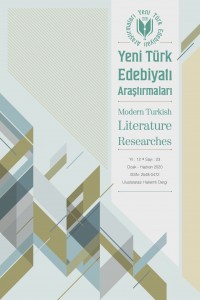Abstract
In this study, it is aimed to analyze the French poet Arthur Rimbaud’s poem “Vowels” through senses. Therefore, the borderlines of an approach which is formed in the frame of cognitive stylistics, also including phenomenological and synesthetic perception is defined. Synesthesia is considered as a phenomenon that transcends senses with its effect on altered states of consciousness, as well as the perception which takes place between and through senses.
Because of the approach to consciousness from a different perspective in the phenomenology, the factors affecting and building the poet’s consciousness are taken into consideration in the stage of analysis. And the altered states of consciousness of the poet, his conflicting moods, the reflections on the language of his tides between the physical and spiritual universe, and his cognitive difference make it appropriate to employ cognitive stylistics as a method, all of these also provide crucial clues about how the poet interferes with cognitive processes.
The figure-ground relationship is considered in cognitive, phenomenological and synesthetic context; when the subject is poetry, it is pointed out that in which area this relationship is revealed and how it is interpreted.
As a result, it is shown that a poem can be analyzed through senses, however, it is observed that senses and the relationships between senses affect the language in connection with both consciousness and mood.
Keywords
Senses literary synesthesia phenomenological perception cognitive poetics/stylistics figure-ground relationship MOOD
References
- Burke, Michael (2005). “How Cognition Can Augment Stylistic Analysis?”. European Journal of English Studies 9/2: 185-195.
- Dann, Kevin T. (1998). Bright Colors Falsely Seen: Synaesthesia and the Search for Transcendental Knowledge. New Haven: Yale University.
- Lawall, Sarah N. (1968). Consciousness: Structures of Literature. Cambridge, Massachusetts: Harvard University.
- Magliola, Robert Rino (1977). Phenomenology and Literature: An Introduction. West Lafayette, Indiana: Purdue University.
- Merleau-Ponty, Maurice (2017a). Algının Önceliği. Çev. Yusuf Yıldırım. İstanbul: Alfa.
- Merleau-Ponty, Maurice (2017b). Algılanan Dünya: Sohbetler. Çev. Ömer Aygün. İstanbul: Metis.
- Özdemir, Fahri (haz.) (2006). Şarhoş Gemi: Arthur Rimbaud. İstanbul: Kırmızı.
- Reverdy, Pierre (1982). “Şiirsel İşlev”. Çev. Adnan Benk. Çağdaş Eleştiri Yıl 2/Ekim: 16-20.
- Stockwell, Peter (2002a). Cognitive Poetics. London and New York: Routledge.
- Stockwell, Peter (2002b). “Miltonic Texture and the Feeling of Reading”. Semino, Elena – Jonathan Culpeper (Ed.). Cognitive Stylistics: Language and Cognition in Text Analysis içinde: 73-94. Amsterdam/Philadelphia: John Benjamins Publishing.
- Stockwell, Peter (2012). Texture: A Cognitive Aesthetics of Reading. Edinburgh: Edinburgh University.
- Tsur, Reuven (2000). “Picture Poetry, Mannerism, and Sign Relationships”. Poetics Today 21/4: 751-781.
- Tsur, Reuven (2002). “Aspects of Cognitive Poetics”. Semino, Elena – Jonathan Culpeper (Ed.). Cognitive Stylistics: Language and Cognition in Text Analysis içinde: 279-318. Amsterdam/Philadelphia: John Benjamins Publishing.
- Tsur, Reuven (2007). “Issues In Literary Synesthesia”. Style 47/1: 30-52.
- Tsur, Reuven (2008). Toward A Theory Of Cognitive Poetics. Brighton – Portland: Sussex Academic.
- Van Campen, Cretien (2010). The Hidden Sense: Synesthesia in Art and Science. Massachusetts: MIT.
Abstract
Bu çalışmada, Fransız şair Arthur Rimbaud’un “Sesliler” adlı şiirini duyulardan hareketle okuma denemesinin gerçekleştirilmesi amaçlandığı için fenomenolojik algılamadan sinestetik algılamaya bilişsel biçembilim çerçevesinde oluşturulacak bir yaklaşımın sınırları çizilmiştir. Sinestezi, duyular arasında ve duyular aracılığıyla algılamanın gerçekleşmesi olduğu kadar, değişen bilinç durumlarına etkisiyle duyuları aşan bir fenomen olarak da ele alınmıştır.
Fenomenolojide bilince farklı bir açıdan yaklaşılması, çözümleme aşamasında şairin bilincini oluşturan ve etkileyen unsurların dikkate alınmasını gerektirmiştir. Şairin değişen bilinç durumları, çelişen ruh halleri, fiziksel ve tinsel evren arasındaki gelgitlerinin dile yansımaları ve bilişsel açıdan farklılığı ise bir yöntem olarak bilişsel biçembilimden yararlanılmasını uygun kılmış, şairin bilişsel süreçlere nasıl müdahalede bulunduğuna dair önemli ipuçları sunmuştur.
Şekil-zemin ilişkisi fenomenolojik, sinestetik ve bilişsel bağlamda değerlendirilmiş; şiir söz konusu olduğunda bu ilişkinin nasıl bir alanda açığa çıktığı ve yorumlandığına dikkat çekilmiştir.
Sonuç olarak, bir şiirin duyulardan hareketle ve duyular aracılığıyla çözümlenebileceği gösterilmiş ancak duyular ve duyular arası ilişkilerin hem bilinç hem de duygudurumlarıyla bağlantılı olarak dile etki ettiği gözlemlenmiştir.
Keywords
Duyular edebi sinestezi fenomenolojik algılama bilişsel yazın/biçembilim şekil-zemin ilişkisi duygudurum
References
- Burke, Michael (2005). “How Cognition Can Augment Stylistic Analysis?”. European Journal of English Studies 9/2: 185-195.
- Dann, Kevin T. (1998). Bright Colors Falsely Seen: Synaesthesia and the Search for Transcendental Knowledge. New Haven: Yale University.
- Lawall, Sarah N. (1968). Consciousness: Structures of Literature. Cambridge, Massachusetts: Harvard University.
- Magliola, Robert Rino (1977). Phenomenology and Literature: An Introduction. West Lafayette, Indiana: Purdue University.
- Merleau-Ponty, Maurice (2017a). Algının Önceliği. Çev. Yusuf Yıldırım. İstanbul: Alfa.
- Merleau-Ponty, Maurice (2017b). Algılanan Dünya: Sohbetler. Çev. Ömer Aygün. İstanbul: Metis.
- Özdemir, Fahri (haz.) (2006). Şarhoş Gemi: Arthur Rimbaud. İstanbul: Kırmızı.
- Reverdy, Pierre (1982). “Şiirsel İşlev”. Çev. Adnan Benk. Çağdaş Eleştiri Yıl 2/Ekim: 16-20.
- Stockwell, Peter (2002a). Cognitive Poetics. London and New York: Routledge.
- Stockwell, Peter (2002b). “Miltonic Texture and the Feeling of Reading”. Semino, Elena – Jonathan Culpeper (Ed.). Cognitive Stylistics: Language and Cognition in Text Analysis içinde: 73-94. Amsterdam/Philadelphia: John Benjamins Publishing.
- Stockwell, Peter (2012). Texture: A Cognitive Aesthetics of Reading. Edinburgh: Edinburgh University.
- Tsur, Reuven (2000). “Picture Poetry, Mannerism, and Sign Relationships”. Poetics Today 21/4: 751-781.
- Tsur, Reuven (2002). “Aspects of Cognitive Poetics”. Semino, Elena – Jonathan Culpeper (Ed.). Cognitive Stylistics: Language and Cognition in Text Analysis içinde: 279-318. Amsterdam/Philadelphia: John Benjamins Publishing.
- Tsur, Reuven (2007). “Issues In Literary Synesthesia”. Style 47/1: 30-52.
- Tsur, Reuven (2008). Toward A Theory Of Cognitive Poetics. Brighton – Portland: Sussex Academic.
- Van Campen, Cretien (2010). The Hidden Sense: Synesthesia in Art and Science. Massachusetts: MIT.
Details
| Primary Language | Turkish |
|---|---|
| Subjects | Creative Arts and Writing |
| Journal Section | Articles |
| Authors | |
| Publication Date | June 1, 2020 |
| Published in Issue | Year 2020 Issue: 23 |
www.ytearastirmalari.com bağlantısındaki esere dayalı olarak.



